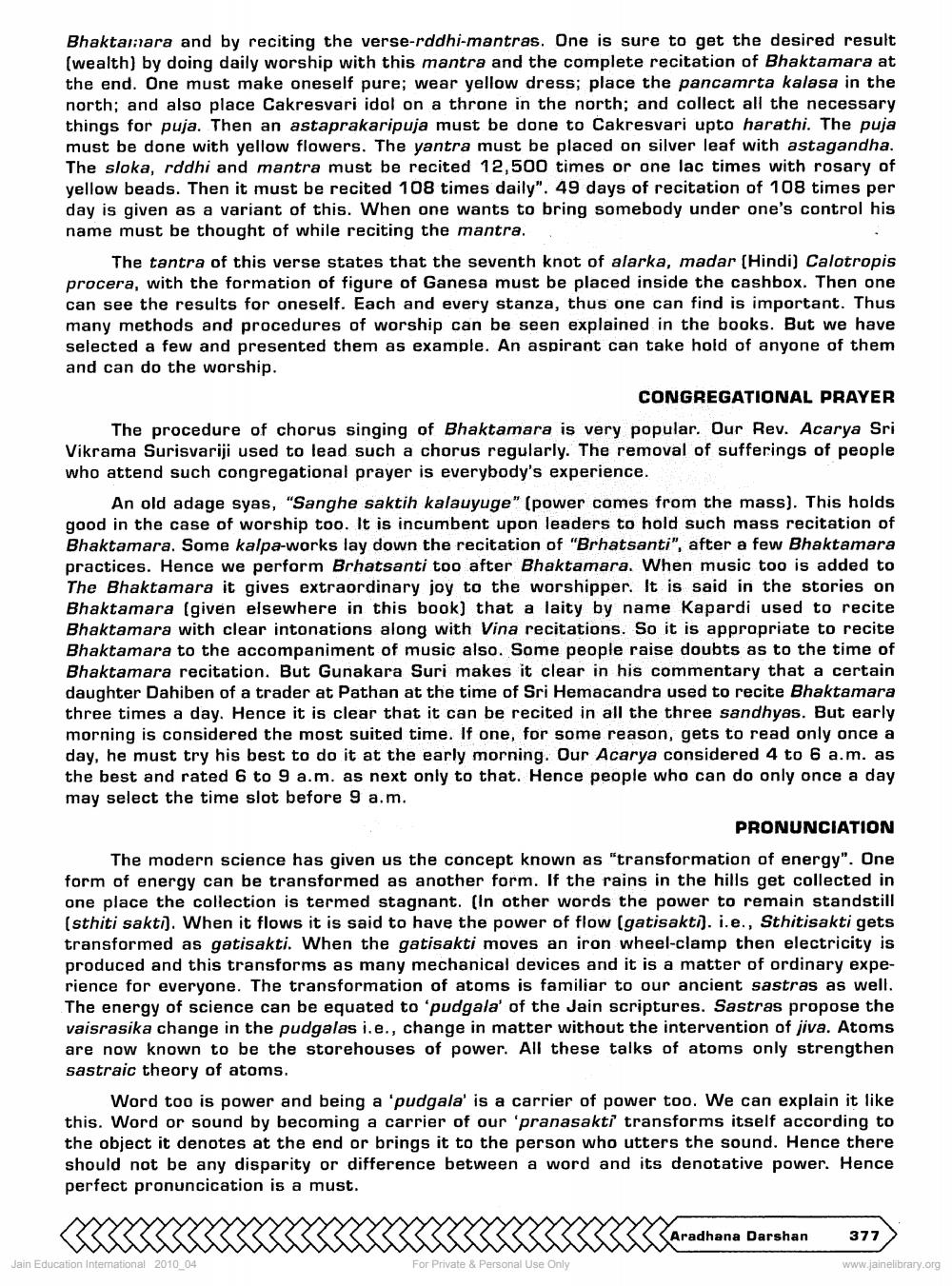________________
Bhaktarara and by reciting the verse-rddhi-mantras. One is sure to get the desired result (wealth) by doing daily worship with this mantra and the complete recitation of Bhaktamara at the end. One must make oneself pure; wear yellow dress; place the pancamrta kalasa in the north; and also place Cakresvari idol on a throne in the north; and collect all the necessary things for puja. Then an astaprakaripuja must be done to Cakresvari upto harathi. The puja must be done with yellow flowers. The yantra must be placed on silver leaf with astagandha. The sloka, rddhi and mantra must be recited 12,500 times or one lac times with rosary of yellow beads. Then it must be recited 108 times daily". 49 days of recitation of 108 times per day is given as a variant of this. When one wants to bring somebody under one's control his name must be thought of while reciting the mantra.
The tantra of this verse states that the seventh knot of alarka, madar (Hindi) Calotropis procera, with the formation of figure of Ganesa must be placed inside the cashbox. Then one can see the results for oneself. Each and every stanza, thus one can find is important. Thus many methods and procedures of worship can be seen explained in the books. But we have selected a few and presented them as example. An aspirant can take hold of anyone of them and can do the worship.
CONGREGATIONAL PRAYER The procedure of chorus singing of Bhaktamara is very popular. Our Rev. Acarya Sri Vikrama Surisvariji used to lead such a chorus regularly. The removal of sufferings of people who attend such congregational prayer is everybody's experience.
An old adage syas, "Sanghe saktih kalauyuge" (power comes from the mass). This holds good in the case of worship too. It is incumbent upon leaders to hold such mass recitation of Bhaktamara. Some kalpa-works lay down the recitation of "Brhatsanti", after a few Bhaktamara practices. Hence we perform Brhatsanti too after Bhaktamara. When music too is added to The Bhaktamara it gives extraordinary joy to the worshipper. It is said in the stories on Bhaktamara (given elsewhere in this book) that a laity by name Kapardi used to recite Bhaktamara with clear intonations along with Vina recitations. So it is appropriate to recite Bhaktamara to the accompaniment of music also. Some people raise doubts as to the time of Bhaktamara recitation. But Gunakara Suri makes it clear in his commentary that a certain daughter Dahiben of a trader at Pathan at the time of Sri Hemacandra used to recite Bhaktamara three times a day. Hence it is clear that it can be recited in all the three sandhyas. But early morning is considered the most suited time. If one, for some reason, gets to read only once a day, he must try his best to do it at the early morning. Our Acarya considered 4 to 6 a.m. as the best and rated 6 to 9 a.m. as next only to that. Hence people who can do only once a day may select the time slot before 9 a.m.
PRONUNCIATION The modern science has given us the concept known as "transformation of energy". One form of energy can be transformed as another form. If the rains in the hills get collected in one place the collection is termed stagnant. (In other words the power to remain standstill (sthiti sakti). When it flows it is said to have the power of flow (gatisakti). i.e., Sthitisakti gets transformed as gatisakti. When the gatisakti moves an iron wheel-clamp then electricity is produced and this transforms as many mechanical devices and it is a matter of ordinary experience for everyone. The transformation of atoms is familiar to our ancient sastras as well. The energy of science can be equated to 'pudgala' of the Jain scriptures. Sastras propose the vaisrasika change in the pudgalas i.e., change in matter without the intervention of jiva. Atoms are now known to be the storehouses of power. All these talks of atoms only strengthen sastraic theory of atoms.
Word too is power and being a 'pudgala' is a carrier of power too. We can explain it like this. Word or sound by becoming a carrier of our 'pranasakti transforms itself according to the object it denotes at the end or brings it to the person who utters the sound. Hence there should not be any disparity or difference between a word and its denotative power. Hence perfect pronuncication is a must.
377
<<<<Aradhana Darshan
w
w
Jain Education International 2010_04
For Private & Personal Use Only
www.jainelibrary.org




